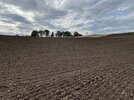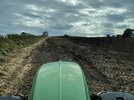Blackwater boy
Moderator
No there was definitely a min till v plough trial there, there might have even been a strip till trial.I thought they had a high input versus a decision based input system. Rothmastead in Knockbeg .
No there was definitely a min till v plough trial there, there might have even been a strip till trial.I thought they had a high input versus a decision based input system. Rothmastead in Knockbeg .
I wrote a 255 page book on it if you want a bit of light reading.Was there ever many results published from it? I’ve no memory of seeing or hearing much about 1 system V the other.

 Rain stopped play last night, got ploughing again at 1 today, rain coming again tonight and the early part of tomorrow, from then on things are looking good.
Rain stopped play last night, got ploughing again at 1 today, rain coming again tonight and the early part of tomorrow, from then on things are looking good.I sometimes really wonder about methodology in these experiments. The way I judge my grand experiment is by making decisions and then checking bank balance at the end of the year. Doing this for five years or more across a rotation would surely be as sound a methodology as any. Record the financials and any observations and hey presto, info a farmer can use. There are things to trial where isolating one variable is necessary, but in a systems trial, surely unnecessary, or am I missing some science stuff here.I wrote a 255 page book on it if you want a bit of light reading.
There was numerous experiments conducted on it over the years but the plot sizes were small. The min-till plots tended to yield better in dry years and the plough based system performed better in wet years.
The problem with a trial like that is the 4 treatments (plough/min-till +/- straw) had to be treated exactly the same to be scientifically sound. Same sowing date, seeding rate, fertiliser application rate and timing. At farm level different establishment systems often require different management strategies but that is not permitted on a trial like this which can provide an unfair advantage to one of the treatments.
Yes, unfortunately you are. While your methods are probably correct, "probably" doesn't cut the mustard, nor should it for such important experimental work. Multi factorial statistical analysis works to a point but the more variables introduced the confidence level falls so far below statistically significant it becomes no better than guess work. Trial work is more difficult than you think.I sometimes really wonder about methodology in these experiments. The way I judge my grand experiment is by making decisions and then checking bank balance at the end of the year. Doing this for five years or more across a rotation would surely be as sound a methodology as any. Record the financials and any observations and hey presto, info a farmer can use. There are things to trial where isolating one variable is necessary, but in a systems trial, surely unnecessary, or am I missing some science stuff here.
What's the book title? Any free copies for F4F membersI wrote a 255 page book on it if you want a bit of light reading.
There was numerous experiments conducted on it over the years but the plot sizes were small. The min-till plots tended to yield better in dry years and the plough based system performed better in wet years.
The problem with a trial like that is the 4 treatments (plough/min-till +/- straw) had to be treated exactly the same to be scientifically sound. Same sowing date, seeding rate, fertiliser application rate and timing. At farm level different establishment systems often require different management strategies but that is not permitted on a trial like this which can provide an unfair advantage to one of the treatments.

Have the film rights been snapped up yet??View attachment 98239
The snappy title made it a best-seller. Be careful what you wish for.
It's on general release October 31st . That "dissertation" took me almost 5 years and won't be forgotten so quickly.Have the film rights been snapped up yet??
I'm trying to remember my own dissertation title but it won't come back to me
Sorry. Not comparing my own measly undergraduate work to your tome, just put me in mind of it was allIt's on general release October 31st . That "dissertation" took me almost 5 years and won't be forgotten so quickly.
View attachment 98323View attachment 98324
Made a start anyway for 2022. Hopefully get Graham in by the end of the week.
God speed the plough.
That isnt a 9880
Any other differences while you are at it....
The 50's aren't the worst. The 100's are hoors for bunching and makes the NASA mattress fierce lumpy.Ya bought a new top link
And a different plough.
Listening to diesel power , better nights sleep with the wads of 50 s gone from under the mattress
Did you buy a one pass in the end Nash?Rightly or wrongly sowing away here tonight. Got caught with the weather this morning.
Did you buy a one pass in the end Nash?
No I didnt stretch that far, still on the shopping list or maybe I'll ask Santa for one.
A friend of mine is one passing it here for me.
